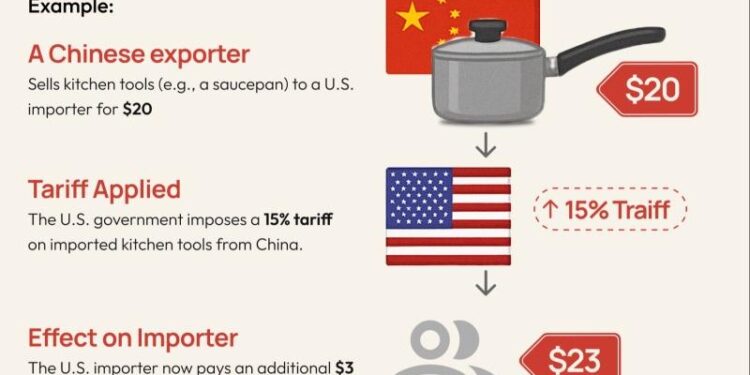As tariffs on imported goods continue to rise, new analysis suggests that the financial burden is increasingly falling on consumers rather than businesses or suppliers. According to a recent Axios report, the costs associated with these tariffs are being passed along the supply chain, culminating in higher prices at the checkout. This development raises concerns about the impact on household budgets and consumer spending amid an already challenging economic landscape.
Customers Face Rising Prices as Tariff Costs Shift Downstream
Recent shifts in tariff structures have led suppliers to pass increased costs directly to end consumers, sparking concerns over affordability and inflation. This downward flow of expenses means, households and businesses alike are facing steeper bills for everyday goods and services. Analysts warn that without government intervention or market adjustments, the financial strain on consumers could intensify, especially in sectors highly sensitive to tariff adjustments.
Key factors contributing to this trend include:
- Supply chain disruptions amplifying the base cost of imported materials
- Regulatory changes requiring compliance investments passed on as tariffs
- Currency fluctuations influencing the ultimate price burden borne by end users
Below is a snapshot illustrating typical tariff impacts on common product categories:
| Product Category | Tariff Increase (%) | Estimated Price Rise (%) |
|---|---|---|
| Electronics | 15% | 10% |
| Household Appliances | 12% | 8% |
| Clothing & Textiles | 10% | 7% |
Retailers Adapt Strategies to Manage Increased Import Expenses
Facing a surge in import costs due to recent tariff hikes, retailers across various sectors are recalibrating their approaches to supply chain management and pricing. Many have started renegotiating contracts with overseas suppliers to secure better rates or shift orders to countries with more favorable trade terms. Additionally, investment in technology-driven inventory management systems is on the rise, aiming to optimize stock levels and reduce holding costs. These efforts, while varied, all converge on one strategic objective: cushioning the financial impact without sacrificing product variety or availability.
Despite internal measures, the reality is that increased expenses are trickling down to consumers. Retailers are cautiously adjusting price tags, with some opting for subtle hikes spread across numerous items instead of steep increases on a few. To illustrate the recent pricing adjustments observed in key retail categories, consider the following overview:
| Category | Average Price Increase | Frequency of Price Changes | Supplier Shift |
|---|---|---|---|
| Electronics | 4.7% | Monthly | From China to Vietnam |
| Apparel | 3.2% | Quarterly | From Bangladesh to India |
| Housewares | 5.1% | Bi-Monthly | Mostly Domestic |
Ultimately, the evolving price structure reflects a complex balancing act, with retailers seeking to maintain competitiveness while navigating the cost pressures imposed by international tariffs.
Experts Advise Consumers to Prioritize Budgeting and Seek Alternatives
With tariffs set to drive up costs, financial experts are urging consumers to adopt stricter budgeting strategies to cushion the impact on their wallets. Prioritizing essential expenses and tracking daily spending have emerged as pivotal steps to maintain financial stability amid rising prices. Experts recommend integrating digital budgeting tools and apps to gain clearer visibility into personal finances, empowering consumers to make informed decisions quickly.
Alongside tightening budgets, exploring alternative options is becoming increasingly vital. From switching to lower-cost brands to buying in bulk and leveraging local produce markets, consumers can mitigate tariff-driven cost hikes effectively. Below is a quick guide to alternative strategies gaining traction:
- Opt for Generic Brands: Often comparable quality at reduced prices.
- Utilize Subscription Services: Discounts on essentials with regular deliveries.
- Shift Energy Usage: Using off-peak electricity rates to save on utility bills.
- Engage in Shared Economy: Carpooling, tool-sharing, and other cost-saving collaborations.
| Strategy | Expected Monthly Savings | Implementation Effort |
|---|---|---|
| Switch to Generic Brands | $20 – $40 | Low |
| Bulk Purchasing | $15 – $35 | Medium |
| Subscribe for Essentials | $10 – $25 | Low |
| Energy Usage Off-Peak | $5 – $15 | Low |
Key Takeaways
As the ripple effects of rising tariffs continue to unfold, it appears that the financial strain will increasingly fall on consumers rather than producers. With supply chain adjustments offering limited relief, customers may soon face higher prices across a range of goods, marking a significant shift in the economic landscape. Policymakers and businesses alike will need to navigate this evolving reality carefully, balancing trade objectives with the everyday financial pressures borne by consumers.































